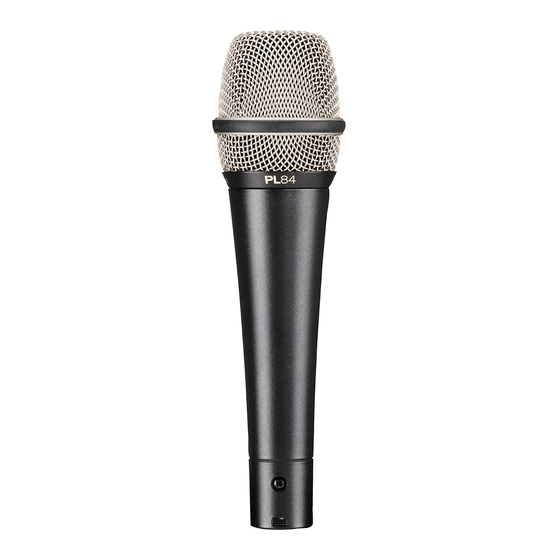Advertisement
Quick Links
Key Features:
•
Voiced for intimate detail and presence
•
Smooth midrange frequency response
•
Cardioid polar pattern
•
High-output self-biased condenser element
•
Shock mounted capsule and low handling noise
•
Fine mesh Memraflex™ grille
General Description:
Thank you for purchasing the Electro-Voice® PL84 (or PL84S
switched version). This product is a professional-grade cardioid
condenser microphone designed to enhance the creative expres-
sion professional singers have built their craft around. With its warm
lows, musical mid-range and smooth high frequency response, the
PL84 captures all of the intimate detail expressive vocalists require.
Should you have purchased the PL84S, in addition to all of the
outstanding performance characteristics of the PL84, you'll also
enjoy the added benefit of a virtually silent on/off switch that allows
electrical muting at the microphone. Although designed to be a vocal
microphone for music and spoken word, the PL84 will also function
well as an acoustic instrument microphone where a condenser ele-
ment capsule would be desired.
Application Notes:
1) This product requires external power to function (see technical
specifications panel for voltage spec), which is commonly supplied
via the Phantom Power function on your sound system mixer or
input module.
2) As with most directional microphones, the low frequency re-
sponse of the PL84 microphone varies with the distance from the
sound source. Known as "proximity effect", the bass response of the
microphone increases as the working distance to the microphone is
reduced. This "bass boost" is only audible when working at distances
closer than 6 inches. Using this microphone at distances greater
than 6 inches provides minimal coloration from proximity effect.
Proximity effect can be used to your advantage when a thin voice
is being recorded. As the vocalist decreases their working distance
to the microphone, the low frequency content is enhanced. Close-
up positioning of the microphone will also reduce the potential for
feedback from the sound reinforcement system. When close-talked,
the bass-boost provides an increase in overall microphone output
level. The mixer gain may be proportionately reduced, resulting in
a reduction of the system's sensitivity to feedback caused by the
sound entering the microphone from the loudspeakers.
Warranty:
This Electro-Voice® PL84 product is guaranteed against malfunction
due to defects in materials or workmanship for a period of three (3)
years from the date of original purchase. Please refer to the Limited
Warranty card included with your product for further warranty infor-
mation.
PL84, PL84S
Cardioid Condenser
Vocal Microphone
Technical Specifications:
Element Type: Self-Biased Condenser
Frequency Response: 50 Hz - 20,000 Hz
Polar Pattern: Cardioid
Sensitivity, Open Circuit
Voltage, 1 kHz:
Polarity: Positive pressure on diaphragm
Rated Impedance: 200 ohms
Max SPL (1% THD @1 kHz): 141 dB SPL
Self Noise: 26 dB SPL, A-weighted
Dynamic Range: 115 dB
Signal-to-Noise Ratio: 68 dB (@94 dB SPL)
Power Requirements: Phantom Supply Requirement:
Microphone Connector: 3-pin, XLR-type
Finish: Textured black satin handle with
Dimensions: Length = 7.18" (182.5 mm)
Accessories Included: Stand adapter with Euro-thread
Net Weight: 9.3 oz (261 g)
Shipping Weight: 18.2 oz (516 g)
3.5 mV/Pa (-49 dBV)
produces positive voltage on pin 2
relative to pin 3
11 to 52 VDC, 1.9 mA
Memraflex
grille
TM
Width = 1.93" (49.0 mm)
Shank = 0.93" (23.6 mm)
insert, Soft zippered gig bag
Advertisement

Summary of Contents for Electro-Voice PL84
-
Page 1: General Description
Although designed to be a vocal microphone for music and spoken word, the PL84 will also function well as an acoustic instrument microphone where a condenser ele- ment capsule would be desired. -
Page 2: Frequency Response
2. The microphone should be located close to the sound source to minimize interference from other potential sound sources. 3. Use the 3-to-1 rule when using multiple microphones. Place each microphone three times farther from other microphones as from the desired sound source.


